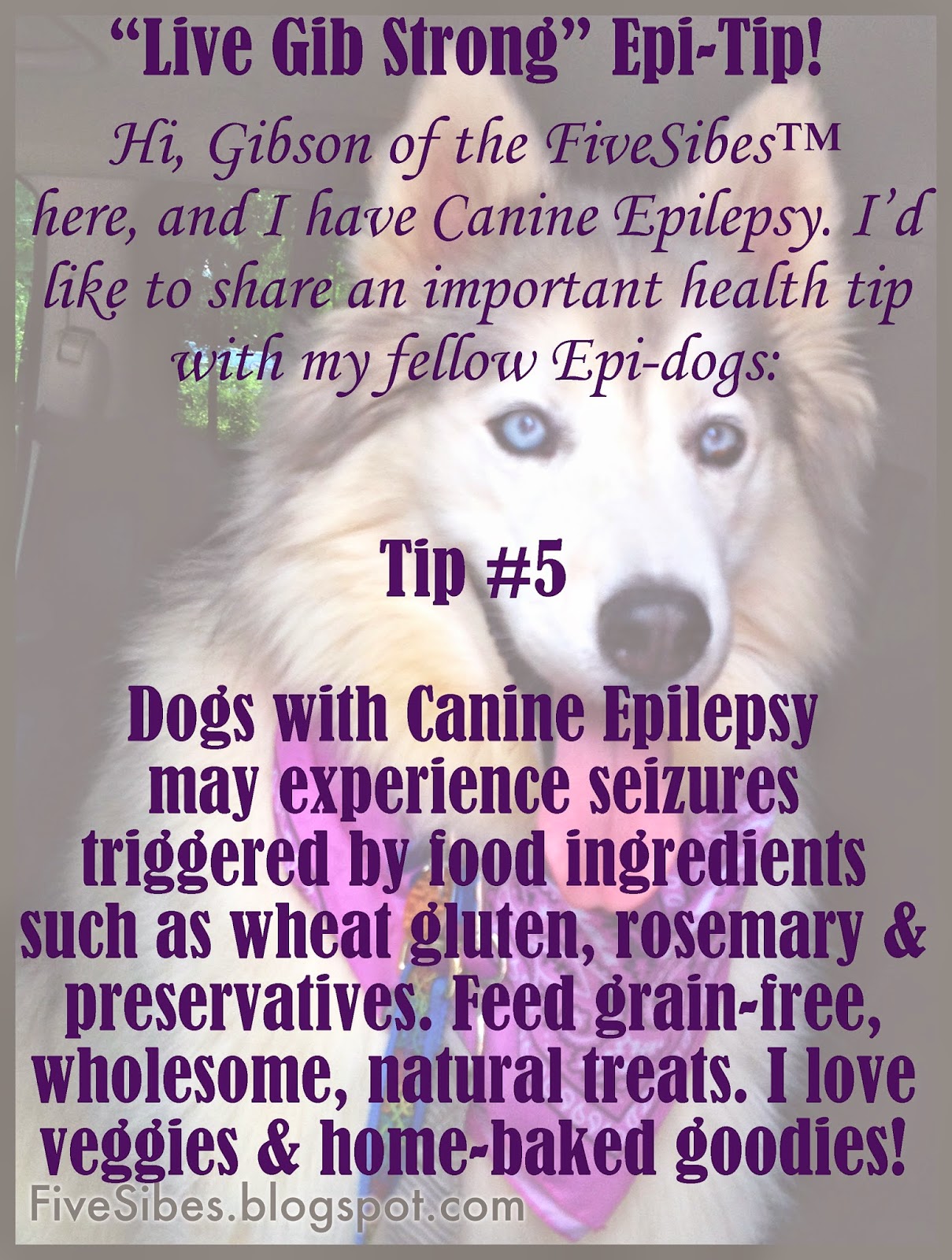#NEAM - Meet "Tucker" ~ A K9 Epi-Star!

That last quote brings back chilling memories for me as that is exactly what I thought when I witnessed my Gibson in the throes of his first seizure back in 2009. Tucker’s Hu-mom continues with Tucker’s story. “When he finally stopped flailing and was just lying there breathing heavy with his tongue hanging out of his mouth, I went to pet him and talk to him and he started growling at me. He had never growled or showed any signs of aggression since we got him at four months old, so it shocked me. I tried again, and he growled again, so I backed away from him. He got up after what seemed like an eternity, but was actually only a few minutes.”
Tucker's Hu-Mom says he went a couple of months doing okay on the Pheno, but, says Tucker’s Hu-Mom, “Until he had them again, and this time a few back to back. He wasn't aggressive when he came out, but was very frantic and blind, and his postictal phase lasted quite a while. We took him to a different emergency vet because the seizures weren't stopping. They kept him overnight because even with the IV meds they were giving him, he was still having seizures.”
As we know, support, research, and a vet with epilepsy experience or a veterinary neurologist, is of utmost importance when caring for an Epi-dog. As a result, Tucker’s Hu-Mom learned new information. “We tried CBD that is made specifically for dogs, but unfortunately he had an opposite reaction to it and had a bad event. They had given us Valium to use nasally as his cluster buster, but he had an opposite reaction to that as well and it heightened his anxiety and triggered more seizures. Tucker had several bad events over the next year or so and had to be hospitalized a couple times. Each time, we were encouraged to give up on him, which I just couldn't do because in between events he has such a love for life that I could never take from him.”
“Finally, Tucker had a severe event and we got him to the emergency vet here and they kept him overnight. They said we needed to pick him up and take him to South Carolina to the emergency vet there that has a team of neurologists, and that they were waiting for us. The ride was about an hour and 15 minutes, and Tucker was hard to control in the car because all the meds had him so anxious. But, we got him there and they took him right in. It was during Covid, so we were not allowed in with him. They told us the neurologist will call. So, we came home and I honestly thought that was going to be the last time I ever saw my boy.”
When Tucker’s Hu-Mom returned home without Tucker, she remembers, “It was so quiet in the house and all I kept thinking was how will I get through it if he never comes home? And, I was not there with him if something happened. Would he think we abandoned him?”
The neurologist called Tucker’s Hu-Mom the next day. She said she was advised that "Tucker was still having seizures, but not as often and that he was eating and drinking.” They did an MRI, and when the neurologist called back, the news was positive. “The neurologist said the MRI was clear and that it was just epilepsy, with no known cause. She advised that larger dogs can be harder to control and that he had refractory epilepsy, and would never have total control. He was a difficult case, but that she was going to add Keppra, as that and the Clorazepate was what was starting to work for him. The next day she called and said he made it through the night and that day with no seizures! He was eating and playing, so we could come get him. They gave us prescription for the medications, which was his new cluster buster.”
The news gets a little better! “Thankfully, Tucker has not had an ER visit since. He has had some episodes that we thought may go that way, but he pulled out of them. The Clorazepate seems to have helped us be able to stop them.”
Besides the few times when he showed aggression postictal, another symptom Tucker experiences is the temporary blindness many dogs do after seizure. “Every time he has one he is blind for about 15 to 30 minutes afterward, so we have to get him on a leash and guide him around the house so he doesn't hurt himself or destroy everything since an 85 lb. Pitt Bull at full charge can do a lot of damage!” Tucker’s Hu-Mom notes that “He paces for an hour or two after, and then sleeps most of the day. A lot of his seizures happen when he is asleep, but they can be day or night.”
Always check with your vet about adding CBD or any type of supplement to your Epi-dog's regimen. Want to check with a holistic veterinarian? Please check HERE on the American Holistic Veterinary Medical Association (AHVMA) site for one nearest you.
To view my FiveSibes blog article on possible triggers, please visit HERE.
“In between seizures, Tucker is the happiest, sweetest boy with a love for life that is infectious. He loves to play ball, swim, go to his favorite sniff spot, destroy stuffies, and all the other things dogs love to do.” ~Tucker’s Hu-Mom
“We have friends that have epilepsy and they have all told me they don't feel pain during a seizure and don't remember it after, so I take comfort in that and assume dogs are the same. Also, dogs live in the moment, so they have no clue that another one is coming. We carry the stress because we worry about when it will happen. I added up the time he spends having seizures and recovering versus the hours between events, and it is less than three percent (3%) of his life, so that also helps me to put it into perspective. We used to get super stressed when the seizures would come, but I realized us getting stressed only made him worse because he feeds off our energy. So, now we remain calm and just move things out of the way, close off rooms, and do all we can to prepare and then just talk to him calmly and work through it.”
“This is never what we would have wanted for Tucker," says his Hu-Mom. "We know that it could shorten his life, but so could many other things. So we don't focus on any of that. We just try and make every day the best it can be for him and do all we can to get him through the tough ones. I never saw myself as having the capacity of being able to care for a special needs dog, but you do what you have to do when the love is so strong. I don't regret any of the choices we have made with Tucker.”
“I added up the time he spends having seizures and recovering versus the hours between events, and it is less than three percent (3%) of his life, so that also helps me to put it into perspective.”~Tucker's Hu-Mom
As a result of their journey with Canine Epilepsy, Tucker’s Hu-Mom started the Tucker’s Tail Facebook page. “I am overwhelmed at the support Tucker has received, and it has really touched my heart. We hope that we can show people that even though a dog may have a disease or condition, it does not define them and that they can still live a full, happy life in spite of it.”
Epi-Dogs Rock!
If you are looking for information on Canine Epilepsy, check out our FiveSibes #LiveGibStrong K-9 Epilepsy Online Resource Library where you will find accurate and vetted information you can trust including links, articles, podcasts with vets and veterinary experts, helpful tips, bookmarks, where to go if you need financial help with epilepsy medications,. Epi-Star success stories, and much more. It's a great place to seek out information so that you can have an in-depth conversation with your vet about your Epi-dog's care.
Return to FiveSibes Main Menu & #LiveGibStrong K-9 Epilepsy Online Resource Library HERE!
💜
Get my book featuring beautiful Epi-dogs across the world:































Tucker and his family are rock stars, helping him live his best life.
ReplyDeleteEpilepsy Warrior Tucker has a pawtastic huMom & family. Stay strong Tucker! 🐾💜🐾
ReplyDelete